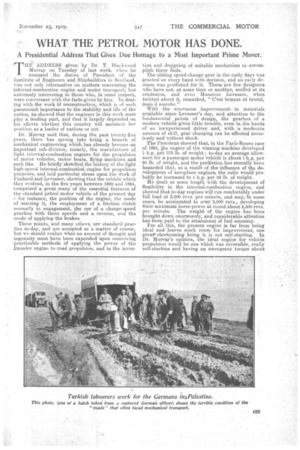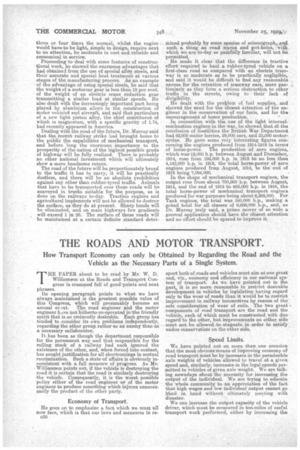WHAT THE PETROL MOTOR HAS DONE.
Page 21

Page 22

If you've noticed an error in this article please click here to report it so we can fix it.
A Presidential Address That Gives Due Homage to a Most Important Prime Mover.'
THE ADDRESS given by Dr. T. Blackwood Murray on Tuesday of last week, when he assumed the duties of President of the Institute of Engineers and Shipbuilders in Scotland, was not only informative on matters concerning the internal-combustion engine and motor transport, but extremely interesting to those who, in some respect, were conyerSant. with the facts given by him. In dealing with the work hi reconstruction? which is of such paramount importance to the stability and life of the nation, he showed that the engineer in this work must play a leading part, and that it largely depended on his efforts whether this country will maintain her position as a leader of nations or not. .
Dr. Murray said, that, during the past twenty-five years, there has sprung into being a branch of mechanical engineering which has already become -an important sub-division, namely, the 'manufacture -of light interrial-cembustion engines for the. prepitision of motor vehicles, motor boats, flying machined and such like. He briefly, sketched the history of the light high-speed internal-conibUstion., engine for propulSion purposes, and laid particular stress upon the work of l'anhard and Levassar, showing that the vehicle which they evolved, in the five years between 1889 and 1594, comprised a great. many of the essential features of the standard petrol motor vehicle of the present day --for instance, the position of the engine, the mode of starting it, the employment of a friction clutch' normally in engagement, the use of a change-speed gearbox ivith three speeds and a reverse, and the mode of 'applying the brakes.
These points, and many others, are standard practice to-day, and are accepted as a matter of course, but we should realize what an amount of thought and ingenuity must have been expended. upon conceiving practicable methods of applying the power of the Daimler engine to road propulsion, and in the inven tion and designing of suitable mechanism to accomplish these ends..
The sliding speed-change gear in the early, days was greeted on every hand with derision, and an early decease was• predicted for it. There are few designers who have not, at some tune or another, scoffed at its crudeness, and even Monsieur Levassor, when twitted about it, remarked, " C'eat brnque et brutal, main ii marche."
With the enormousimprovementin materials available since Leva,ssor's day, and attention to the fundamental points of design, the gearbox of a modern vehicle gives little trouble, even in the hands of an inexperienced driver and; with a moderate amount of skill, gear changing can be effected noise lessly and without shock. , • • .. The President showed that, in the Paris-Rouen race of 1894, the engine .of the winning machine developed h.p. per 370 lb. Of weight ; to=day an average allowance for a pa.sSenger Motor vehicle is about 111.P. per 80 lb. of weight, and the Prediction, has recently been hazarded that, as a result of the influenceof the development of aeroplane engines, 'the ratio would pro-bably be increased to 1 h.p. per 56 lb. of weight.
11-edealt at some length with the development of flexibility in the internal-combustion engine, and showed that to-day engines will 'run comfortably under full load at 5,000 revs. Per Minute, and may, 'in some oases, be accelerated. to over 3,000 revs., developing their maximum hoise-power at round about 2,509 revs. per .minute. The . weight of the engine has .bc'en brought down enormously, and considerable attention has-been paid to the attain/neat of fuel eoonenay. For all this, the present engine is far from being ideal and leaves mach room for improvement, one great, shortcoming being it is not self-starting. In Dr. Murray's opinion, the ideal. engine, for vehicle propulsion would be one which was' reversible,.really self-starting and having an emergency torque about three or four times the normal, whilst the engine weuld have to be light, simple in design, require next to no attention, be moderate in cost and reliable and economical in service.
Proceeding to 'deal with some features of constructional work, he showed the enormous advantages that had obtained from the use of special alley steels, and their accurate and special heat treatment at various stages of the manufacturing process. As an example of the advantage of using special steels, he said that the weight:, of a motorcar gear is less than 12 per cent. of the weight of an electric crane reduction gear transmitting a similar load at similar speeds. He also dealt with the increasingly important part being played by aluminium alloys in the construction of motor vehiele and aircraft, and said that particulars of a new light piston alloy, the chief constituent of which is magnesium, with a specific gravity of 1.74, had recently appeared in America. Dealing with the road of the future, Dr. Murray said that the recent railway strike had brought home to the public the capabilities of mechanical transport, and before long the enormous importance to the prosperity of the nation of the highest possible grade of highway will be fully realized'. There is probably no other national investment which will ultimately show a more handsome return.
The road of the future will be proportionately broad to the traffic it has to carry, it will be practically dustless, and there will be an absolute prohibition against any other than rubber-tyred traffic'. Animals that have to be transported over these roads will be conveyed in trucks suitable for the purpose, as is done on the railways to-day. Traction engines and agricultural implements will not be allowed to destroy the surface, as they do at present. Sharp bends will be eliminated, and on main highways few gradients will exceed 1 in 20. The surface of these roads will be maintained at a tertain'clefinite ,standard deter mined probably by some species of seismograph,asy such a thing as road iwaves and pot-holes, sari which we are to-day so painfully familiar, will not 0 permitted. He made it clear that the difference in tractive effort required to haul a rubber-tyred vehicle on a first-class road as compared with an. electric tramway is so moderate as to be practically negiigiblel and said it would be difficult to find any reasonable excuse for the retention of tramway cars, more particularly as they form a serious obstruction to other traffic in the streets, owing to their laek of dirigibility.
He dealt with the problem of fuel supplies, and showed the need for the closest attention of the engineer in the conservation of our fuels, and for tha.
encouragement of home production. .
In connection with the use of the light internalcombustion engines in the war, he showed that at the conclusion of hostilities the British War Department had 62,000 motor lorries, 28,000 ears, and 33,000 motorcycles. He gave some very interesting figures concerning the engines produced from 1914-1918 in terms of horse-power. The production of aero engines, which was 12,000 h.p. between August and December, 1914, rose from 195,000 h.p. in 1915 to no less than. 4,140,000 h.p. in 1918, the 'total horse-power of aero engines produced from August, 1914; to the end of
1918 being 7,094,000. .
In the shape of mechanical transport engines, the output rose from about 750,000 h.p. between August, 1914, and the end of 1915 to 662,000 h.p. in 1818, the total horse-power of mechanical transport engines produced for war purposes being about 2,232,000. For Tank engines, the total was 340,000 h.p., making a. grand total for all classes of 9,666,000 h.p., and, as Dr. Murray truly said, a prime mover of so wide a general application should have the closest attention and no effort should be spared to improve it.








































